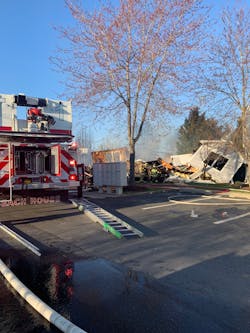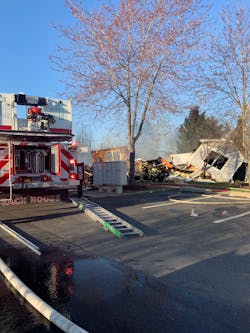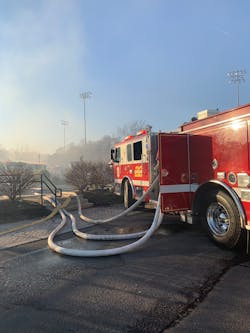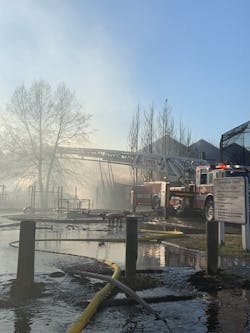In this month’s Close Calls column, we continue to learn from the North Beach Volunteer Fire Department (NBVFD) in Calvert County, MD. On April 3, 2019, NBVFD responded to a working multi-family dwelling fire with simultaneous challenges. Our focus will now be on specific accounts from some of the firefighters and officers who operated at this fire, as well as a review of lessons learned and reinforced. You can read Part 1 here.
On that day, a fire started in a pile of freshly spread mulch outside a row of four elevated, wood-frame townhomes. The fire, fueled by high winds, vinyl siding, lightweight construction and delayed fire department notification, claimed the lives of two occupants and nearly claimed the lives of two firefighters attempting to locate the victims.
This fire provides insight as to the operations and multiple roles that members of volunteer departments must fill. Calvert County, like most of the Washington-Baltimore region, runs a very aggressive “box alarm” automatic mutual aid system assuring plenty of staffing on a first-alarm assignment. Part of the response is a unique program that Calvert County uses, where qualified volunteer fire officers fill the role of “battalion chiefs” from every department in the county. For example, with a north and south duty officer it provides an extra set of command level “hands” in supporting the incident.
I mention the above because there are still areas of North America where the local fire leadership refuses to consider automatic mutual aid, multiple chief responses, shared resources and other progressive ideas that provide help to those having the emergency and those responding. The more we look at what is best for those having the emergency the clearer it is to see what doing the “right thing” means.
Firsthand accounts
The following accounts are from those involved in the incident.
Safety Officer Danny Morrison
On April 3, 2019, at approximately 1600 hours, Area Box 106 was dispatched. I was a block away from the incident. As I approached the scene, I was able to contact the control center via radio to confirm it was a working fire and to dispatch an additional alarm.
I arrived on the scene and gave a size-up with fire showing from the Alpha, Bravo and Delta sides. I donned my gear and upon the arrival of Engine 11 utilized an SCBA off the apparatus and joined the crew. I was advised by Calvert (dispatch) there were subjects trapped in the structure in a bathroom but not specifically where.As Engine 11’s officer stretched the 200-foot 1½-inch handline to the structure, I donned my facepiece. I was advised by the driver of Engine 11—Fire Chief Chris Mills—and numerous bystanders that the trapped individuals were in our place of entry. The handline was opened, and initial attack was begun by Firefighter Max Ondrusek. I forced the door to the structure and fire was knocked down. I asked for the line to knock down the first room. I handed the line to Ondrusek and began searching. I tried to make the steps to my left in the first room, however, fire conditions were unbearable at this point and I noticed the steps were impassable. I began to search down the hallway and located a room off to the left side. I had a clear visual of the room. It appeared to be a bathroom with nobody inside. I began searching farther into the structure coming within little distance to the side Charlie wall. I advised Command we would need an additional line as the fire was intensifying.
At this time the floor began cracking and walls were beginning to fail. I yelled for Ondrusek to get out. As I tried to exit, the floor gave way and I fell waist deep into the crawl space that was fully involved with flames. With no time to spare I attempted to call a mayday. I self-extricated out of the crawlspace and lunged toward the door. The temperature at this point was unbearable and I noticed extremely hot air from my SCBA. I blacked out at this time. When I came to, I had been removed to the front yard by Tyler Mills, Mark Tyrell and James BoBo. I was evaluated by EMS and transported to Medstar Washington Hospital Trauma Center.
Firefighter Max Ondrusek
I was the officer of Engine 11 that Wednesday. Matt Doss and I were the only ones at the station when the box alarm went out. We immediately started to get dressed in the station then Chief Mills arrived to drive. He said it was a working fire and to be ready. En route I heard people were trapped. Upon arrival Doss exited the truck and laid out the supply line and connected to the hydrant. Danny Morrison was already on scene and getting dressed.
As we progressed forward and got settled, I pulled a crosslay and flaked out the line. As soon as we got water, I started to hit the fire from the outside working my way across the home. Morrison finished getting dressed and came over to me. I handed him the line as he had more experience and I backed him up. We received confirmation from a civilian as to which house people were trapped in (second unit from fully involved end unit) and we made entry through the Alpha side door. We continued in knocking down the fire and performing a search and rescue operation. As we got to the middle of the house, surprisingly there was excellent visibility and little smoke. We got to the center down the hall where the steps would have been, however, the steps were burned all the way through. On the Charlie side, the house was fully involved, and it was impossible for us to get back there.
Just then the Incident Commander (IC) called an evacuation tone and we turned around to get out. Then the floor broke out from underneath of us. Morrison and I fell through the floor. I thought he was right behind me. I was able to crawl up toward the window. On the Delta side you could see the walls deteriorating and beginning to collapse. I couldn’t see the door at the time. As I made my way to the Alpha side window, I climbed out and fell to the ground. They said Morrison was still inside, so I turned around to go back and as I turned around, I saw his helmet through the smoke. I ran up to him as he collapsed on the porch. I dragged him off the porch to the lawn when Mark Tyrell and Tyler Mills dragged him to the road and undressed him. I then continued to undress myself and get some water. After a few minutes, I redressed and went back to help back-up lines to help prevent the other houses from catching fire. After a few minutes, I ran out of air in my SCBA and went to replace it. From there I got more water then backed up Mills on the 2-inch line with the Delta side collapse. Again, after some time, I got more water and was told to go see the medic unit where they found first- and second-degree burns on my shoulder, ear and part of my face. I was transported to a health center and discharged shortly after.
Fire Chief Chris Mills
When I arrived on location, I parked on side Alpha of the fire structure. I exited the vehicle and noticed that we had heavy fire on the Alpha/Bravo side of unit 3889 with extension to three other townhouses in the row. It appeared that most of the fire was at ground level and through the Charlie side of the roof. I charged the initial attack line. I had a citizen advise me that there were still people inside the structure, and they were pointing to the second townhome from the end, which would be next to 3889. At this time, I met with the linemen and Safety Officer Morrison and advised them of what the citizen had told me. I hooked up my intake and when I returned to the Alpha side of the building, I noticed that we had a structural collapse of 3889. At this time, I noticed Morrison and Ondrusek entering the structure, which was next to 3889. There was not much fire involving the structure when they entered. But, 30 seconds later, we had a gust of wind come through and the townhouse went up in heavy fire.
I saw Ondrusek exit the building through a window on side Alpha. The structure they had entered was starting to collapse, all while Morrison was still inside. At this point, I turned to Deputy Chief Tim Clark from Huntingtown, who had command, and advised him to call a mayday for Morrison. Clark advised that he had called the mayday. Within one minute of the mayday being sounded, Morrison appeared to be crawling out of the structure and then I noticed three members of departments assisting Morrison from the structure to the street. At this time, I had a second attack line pulled from the wagon and charged it. All while a new row of townhouses had caught fire to the north of 3889. Another firefighter and I removed 200 feet of 3-inch hose from Engine 11 and ran it to Tower 1 to supply the ladder pipe. Within three minutes, we had the ladder pipe in operation flowing a master stream. Then Engine 12 arrived on location to supply me water and I ran an additional 3-inch line from Engine 11 to Engine 12 with Firefighter Bromley. Then the 2-inch 200-foot line with a stack-tipped nozzle was pulled and placed in service by members from another department. At this time, I had two crosslays working, which were 1½-inch hose and a 2-inch line with a smooth bore nozzle in operation along with the ladder pipe. An Anne Arundel County crew approached me to pull a RIT line, which was a 250-foot 1½-inch line. A crew from Huntingtown approached me next to pull the front bumper line and I charged it. Then we went to complete master stream operations with Tower 1 (North Beach), Tower 2 (Prince Frederick-Calvert) and Tower 40 (Anne Arundel ).
I responded to Area Box 106, 3885 Gordon Stinnett Ave. for the reported house fire with people trapped. I responded as Chief 6B from my residence. While en route, Calvert Dispatch advised responding companies that they were receiving numerous calls of a townhouse well involved and a female trapped in the bathroom in unit 3889. Calvert was calling for any chief officer from Company 1 with no response, so Huntingtown Chief 6A advised Calvert to start the second alarm. I arrived on the scene in the rear and parked in the playground area. The scene from the rear was hard to assess, due to the smoke and burning trees. As the first-arriving chief officer, I did a walk around to side Alpha to see that Engine 11 was the only unit on the scene. They had laid out a supply line and advanced a line into unit 3881.
We had a four-unit row of townhouses with heavy fire on the exterior and underneath all three units, extending to the fourth of the center row with extension to the Bravo exposure. The unit 3881 that Engine 11’s crew had entered appeared tenable on the interior from what I could see from the front door.
I spoke with Chief 1 and he advised that he was driver on the engine, so I called Calvert and established command. I advised I had three units fully involved. Calvert advised me that there was a female trapped in 3885 and it was collapsing. I ran to the Bravo side to see if I could make it around to the rear. As I got to the Bravo side, the unit shifted about two feet over from the top. I turned around and got back to side Alpha as the Bravo end unit collapsed. I notified Calvert of the collapse. Safety 1 called to advise he needed another line, as he was not making any progress. I advised him to come out and told Calvert to sound the evacuation tones. Before Engine 11’s crew could make it out of the house, unit 3881 and 3885 collapsed. I called the mayday for Safety Officer Morrison.
Just prior to the collapse, I saw Morrison coming down the steps. I did not see Firefighter Ondrusek. The unit collapsed at this time. The only units on the scene that I knew of were E11 and Tower 1. Firefighter Bobo from Company 6, Firefighter Mills, and Firefighter Tyrrell from Company 1 proceeded to the front of the structure to find E11’s crew.
Ondrusek appeared and came out through the front window of the collapsed unit and was assisted out to the parking lot. Morrison appeared in what was left of an opening that was the front door, where he was grabbed by Bobo, Tyrrell and Mills and carried to the parking lot. I advised Calvert to clear the mayday and start EMS to side Alpha. Ambulance 59 (Dunkirk VFD) started to attend to Morrison and advised they were requesting aviation. I called Calvert and advised them to have the medic go to 59, that they were requesting aviation and that they would be going to TAC 2.
Huntingtown Chief 6A arrived and I assigned him side Alpha. I looked off at unit 3877 and saw members from Company 5 (Dunkrik VFD) starting to enter from the front. I then told them, face-to-face, not to go in. Exterior ops only. I then went back to E11. Sergeant 5 called me and said they had a report from a citizen that there was someone trapped in unit 3877. I went to Chief 6A and had him go with E52’s crew and clear 3877. Chief 5A arrived. I assigned him to side Charlie and advised him they needed to get a draft set up in the creek because E11 wasn’t getting good water. If they used the hydrant in the rear, we were going to lose water in the front.
Captain 6 was assigned water supply. Tower 1 was setup on side Alpha, supplied by E11. Tower 2 and Tower 845 were setup on side Charlie supplied by Engines 61, 21 and AA (Anne Arundel County) E9, AAE422 assigned RIC, A59 assigned EMS/rehab on TAC 2, Chief lA Safety and Chief lC was assigned PIO.
Anne Arundel Special Ops Chief 335 Spriggs arrived at command and set up in the front of E11 and assisted Command.
As PAR checks were being done by Chief Spriggs, Tower 1 advised me they were looking for Firefighter Rob Wyatt from Company 1. I called for Wyatt off the radio with no answer. At that point, I called for the mayday for Wyatt. Mayday tones were sounded by Calvert. Wyatt was found operating with Company 6 and 5 units in the Bravo exposure 3905. The mayday was cleared.
The Delta exposure 3877 was searched and cleared by C6A and E52. C6A, E62 and ESl worked the Bravo exposures from side Charlie. All searches were negative. Unit 3893 started to collapse. All units were directed to stay clear of the collapse zone. Crews from both sides were able to control the extension in 3901, 3905 and 3897. All personnel were accounted for and with all exposures known under control. Units were sent to rehab and the Towers continued to extinguish the collapsed main fire buildings.
Tower 1 reported that they had done as much as they could with Tower ops. A plan was formed with the fire marshals and C6A to work the pile with handlines so that the fire marshals could start their investigation. While units were working the pile, C6A found and confirmed the location of the two victims and the service dog. Fire marshals and sheriff’s office personnel completed their investigation and the victims’ removal. I updated Calvert that all units were accounted for and sent to debriefing, held with units from Co. 1. Command was then turned over to Chief IA.
My take on the incident
While there is much to review about this fire, I would like to focus on response, specifically responses involving volunteer fire departments with “home” or off-station response. While size-up, conditions, search, rescue, fire attack, mayday response and all the other tasks we are required to perform are critical, none of that will happen if there is not an appropriate dispatch, deployment and response plan.When a volunteer department has determined that paging out and related home/work response is the way to provide service, it must be done with consideration going to those who are having the fire.
A volunteer fire department must consider:
- Expected response (using phone apps allows immediate understanding of who is responding)
- Historical response
- Required number of firefighters immediately needed based upon the run, for example:
What is your needed staffing for a working fire with possible people trapped in a one-story, 1,000-square-foot single-family dwel ling in a reliable hydrant area? Day? Night?
What is your needed staffing for a 15,000-square-foot industrial building with fire and hazmat? Daytime response? Nighttime response?
What is your needed staffing for a multi-family dwelling during the day, with a working fire and reported occupants within?
The NBVFD made some extreme attempts—well-justified attempts—to save lives at this fire. Unfortunately, the outcome wasn’t what they had hoped for and some members ended up in mayday scenarios doing what they are expected to do—search and rescue.
What’s most critical in this fire for readers to learn from is that North Beach functions as a part of their regional fire service.
- The first alarm wasn’t “just” the NBVFD, but included numerous departments being alerted.
- The county VFDs got together and created these “automatic” responses to assure response when someone calls 9-1-1.
- Various volunteer fire officers from around the county cover as “battalion chiefs” responding into each other’s areas to ensure the command role is covered. In this case, as you read, the NBVFD chief drove the first engine—and that is the reality of a VFD. However, unlike many areas in North America served by volunteers, they had numerous other companies on the initial dispatch and that also included chiefs who are trained to command the incident, regardless of the jurisdiction.
This was by any definition a tough fire, from the environmental conditions and heavy fire on arrival in lightweight truss construction, to water challenges, to the most critical factor—numerous occupants trapped. They had their hands full. Upon arrival, size up, water supply, lines stretched, search, rescue, attack and all other considerations, it must be understood that these tasks should be conducted simultaneously. If they are performed one at a time, the fire will win every time.
When considering response plans, North Beach set the example. By having an aggressive first-alarm assignment with numerous resources alerted simultaneously, and without hesitation to strike additional alarms even before arrival, they are doing what’s best for those requiring help and those responding to help.
Our hearts go out to those who experienced this loss and to those firefighters who gave it their all to attempt these challenging rescues. The NBVFD and the Calvert County Fire and Rescue agencies have provided a model and example on how to maximize available resources regardless of community borders, districts, jurisdictions and perhaps most importantly, regardless of egos.
They have a system in place to do what’s best for those served based upon currently available resources. Of course, it requires sitting down with all neighboring agencies with a focus on what’s best. It means common policies, procedures, standards and training to create a system allowing neighboring departments to work well together.
What is being done in Calvert is a model that many volunteer departments in North America should strongly consider, sooner than later.
About the Author
Billy Goldfeder
BILLY GOLDFEDER, EFO, who is a Firehouse contributing editor, has been a firefighter since 1973 and a chief officer since 1982. He is deputy fire chief of the Loveland-Symmes Fire Department in Ohio, which is an ISO Class 1, CPSE and CAAS-accredited department. Goldfeder has served on numerous NFPA and International Association of Fire Chiefs (IAFC) committees. He is on the board of directors of the IAFC Safety, Health and Survival Section and the National Fallen Firefighters Foundation.





